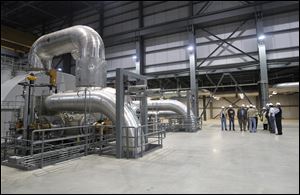
ELECTRICITY GENERATION
Natural gas plants in demand as rules drive wind, solar
7/24/2015
Men tour of AMP Fremont Energy Center, a natural gas-run electric plant.
As tougher environmental rules prompt wider use of wind and solar power, small, nimble natural gas plants will be needed to ensure the lights stay on.
Combined cycle gas plants are easier to switch on and off than coal or nuclear generators, John Rowe, chairman emeritus for Exelon Corp., said in an interview this week at the Energy Thought Summit in Chicago. That feature makes it easier for gas-fired power to fill in the gaps when the wind doesn’t blow or the sun doesn’t shine.
While coal’s downfall in a changing energy world is well documented, nuclear power is also being squeezed by an expansion of renewables and a flood of cheap gas that’s come from a boom in shale drilling, said Mr. Rowe, who led Exelon for 12 years before retiring in 2012.
Nuclear power is “in between two blades of the scissors coming together,” Mr. Rowe said. “The combination of energy efficiency and the aftereffects of the recession have reduced the need for electricity.”
Mr. Rowe is well positioned to forecast the future of nuclear power. The Chicago-based utility he ran is the largest U.S. nuclear operator.
In April 2014, after Mr. Rowe’s departure, Exelon agreed to buy Pepco Holdings Inc. in a move to expand its assets in the mid-Atlantic region and reduce reliance on atomic power.
Large power plants aren’t yet headed for extinction “but we’ll need combined cycle natural gas,” Mr. Rowe said.
In April, gas surpassed coal as the largest source of electricity generation in the United States, according to data from the Energy Information Administration.
Nuclear, which has the benefit of producing electricity without emitting planet-warming carbon dioxide, remains stigmatized by accidents such as the 2011 Fukushima Dai-ichi nuclear meltdown in Japan, Mr. Rowe said.
The fuel accounts for about 19 percent of electricity generation.
Gas’s gain is coal’s pain. The amount of electricity produced from coal has fallen to 36 percent from about 50 percent a decade ago, EIA data show.
“Coal-fired electricity is like the dinosaurs, it’s dying, but very slowly,” Mr. Rowe said.